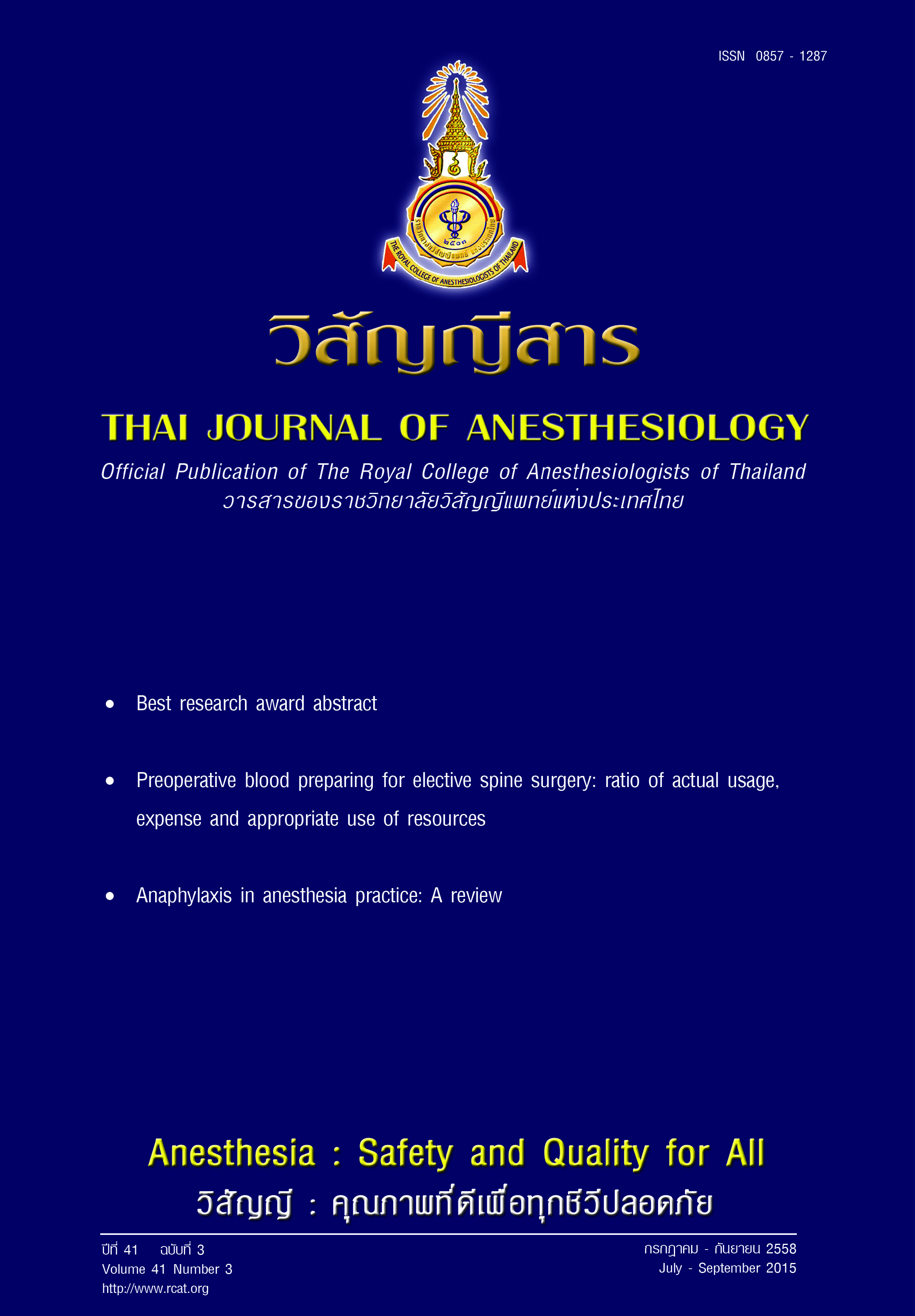Comparing Low Dose Intrathecal Morphine with Femoral Nerve Block for Pain Control after Fixation of Extracapsular Hip Fracture on Top of Spinal Anesthesia: a Randomized Controlled Clinical Trial
Main Article Content
Abstract
Introduction: 0.1 mg intrathecal morphine can provide effective pain control after extracapsular hip fracture but must be weighed with possible complications in these fragile patients. The benefit of femoral nerve block (FNB) has yet to be conclusively proven.
Objective: This study compared the effectiveness of postoperative pain control between 0.1 mg intrathecal morphine (IT-gr) and 20 ml of 0.25% bupivacaine for FNB (FNB-gr) on top of spinal anesthesia (C-gr).
Method: The study was a randomized, controlled trial conducted from January 2011 through August 2012 at Siriraj Hospital. Fifty one patients were randomized into three groups (17 for each group: spinal anesthesia or controlled group (C-gr), spinal anesthesia with intrathecal morphine (IT-gr) and spinal anesthesia with femoral nerve block (FNB-gr). After operation, all patients received intravenous patient-controlled analgesia (IV PCA) for 48 hours. On-demand doses of PCA morphine were recorded at given times. Every patient was evaluated at 3, 6, 12, 24 and 48 hours for visual rating scale of pain, satisfaction, sensory and motor recovery, and side effects.
Results: There were no significant differences between groups with respect to age, sex, body mass index, ASA physical status, site and operative time. Time to first rescue morphine was significantly longer in IT-gr than C-gr (470 vs 97 min, p = 0.003) but no significant difference between FNB-gr and C-gr. More than 50% reduction of 24 hours morphine consumption was found in IT-gr, and significantly lower than with C-gr (6.6+7.5 vs 14.2+5.5 mg, p = 0.007). The average pain scores in all groups were lower than 4 at any time after operation and these were not clinically significant. More patients in IT-gr rated “excellent” in the first 24 hours and significantly higher than the others. There was no serious complication found in the study and only a few patients had side effects.
Conclusions: 0.1 mg intrathecal morphine, not FNB significantly extends the postoperative pain-free period for fixation of extracapsular hip fracture without serious complication – a key concern in elderly patients.
การศึกษาเปรียบเทียบประสิทธิภาพการระงับปวดภายหลังการผ่าตัดกระดูกสะโพกหัก ด้วยเหล็กดามระหว่างการทำ Femoral nerve block และการให้มอร์ฟีน 0.1 มก ในช่องไขสันหลัง
บทนำ: มอร์ฟีน 0.1 มก. ที่ฉีดเข้าช่องน้ำไขสันหลังมีผลการระงับปวดที่ดีสำหรับการผ่าตัดใส่เหล็กดาม ที่ข้อสะโพกหักนอกแคปซูลแต่ต้องพิจารณาถึงภาวะแทรกซ้อนที่อาจเกิดขึ้นได้โดยเฉพาะในผู้ป่วยเปราะบาง ประโยชน์ของการฉีดยาชารอบๆ เส้นประสาทฟีมอรัลสำหรับการผ่าตัดนี้ยังไม่สามารถสรุปได้ชัดเจน
วัตถุประสงค์: การศึกษานี้เปรียบเทียบผลการระงับปวดหลังผ่าตัด ระหว่างการให้มอร์ฟีน 0.1 มก. ฉีดเข้าช่องน้ำไขสันหลัง หรือ การฉีดยาบิวพิวาเคน 0.25 % จำนวน 20 มล. รอบๆเส้นประสาทฟีมอรัล ในผู้ป่วยที่ได้รับการ ระงับความรู้สึกด้วยวิธี spinal block
วิธีการศึกษา: การศึกษาเป็นการศึกษาควบคุมแบบสุ่มทำที่โรงพยาบาล ศิริราชในช่วงเดือนมกราคม พศ. 2554 ถึงเดือนสิงหาคม พ.ศ. 2555 ผู้ป่วย 51 คน ได้รับการแบ่งกลุ่มโดยการสุ่ม เป็น 3 กลุ่มๆ ละ 17 คน กลุ่มควบคุม (C-gr) ผู้ป่วยจะได้รับการฉีดยาชาเข้าไขสันหลังอย่างเดียว กลุ่มที่สอง (IT-gr) ผู้ป่วยจะได้รับมอร์ฟีน 0.1 มก. พร้อมการฉีดยาชาเข้าไขสันหลัง และกลุ่มที่สาม (FNB-gr) ผู้ป่วยจะได้ รับยาบิวพิวาเคน 0.25 % จำนวน 20 มล. รอบๆ เส้นประสาทฟีมอรัล ร่วมกับการฉีดยาชาเข้าไขสันหลัง ผู้ป่วย ทุกคนหลังการผ่าตัดจะได้รับยามอร์ฟีนเข้าทางหลอดเลือดดำแก้ปวด ผ่านเครื่องที่ควบคุมโดยตัวผู้ป่วยเอง (patient-controlled analgesia (PCA)) มีการประเมินค่าความปวดเมื่อ 3, 6, 12 และ 24 ชั่วโมงหลังการผ่าตัด และมีการประเมินความพึงพอใจต่อวิธีการระงับปวดที่ได้รับ ภาวะแทรกซ้อน อาการชาหรือขาอ่อนแรง
ผลการศึกษา: ไม่พบความแตกต่างระหว่างกลุ่มในแง่ของอายุ เพศ ดัชนีมวลกาย สมรรถภาพร่างกายแบ่งตาม ASA ตำแหน่งและระยะเวลาการผ่าตัด ในกลุ่มที่ได้รับมอร์ฟีนทางช่องน้ำไขสันหลัง มีระยะเวลาการระงับปวด นานกว่าโดยได้ยามอร์ฟีนทางหลอดเลือดดำครั้งแรกเมื่อเวลา 470 นาทีเปรียบเทียบกับ 97 นาทีในกลุ่มควบคุม (p = 0.003) และใช้ยามอร์ฟีนใน 24 ชั่วโมงแรกน้อยกว่า (6.6+7.5 มก. เทียบกับ 14.2+5.5 มก., p = 0.007) แต่ไม่มีความแตกต่างทางนัยสำคัญทางสถิติระหว่างกลุ่ม FNB กับกลุ่มควบคุม ผู้ป่วยทุกคนได้ค่าคะแนน ความปวดที่น้อยกว่า 4 ตลอดระยะเวลาของการศึกษา กลุ่ม IT ให้คะแนนความพึงพอใจในเกณฑ์ดีมากสูงกว่า กลุ่มอื่นๆ ภาวะแทรกซ้อนพบน้อยมากในผู้ป่วยทุกกลุ่ม
สรุป: มอร์ฟีนขนาด 0.1 มิลลิกรัมที่ฉีดเข้าช่องน้ำไขสันหลัง เพิ่มระยะเวลาที่ผู้ป่วยไม่รู้สึกปวดหลังการผ่าตัดใส่เหล็กดามในผู้ป่วยที่กระดูกสะโพกหักแบบ นอกแคปซูล โดยมีภาวะแทรกซ้อนน้อยมาก ซึ่งเป็นประเด็นที่สำคัญ ในการดูแลรักษากลุ่มผู้ป่วยสูงอายุ


